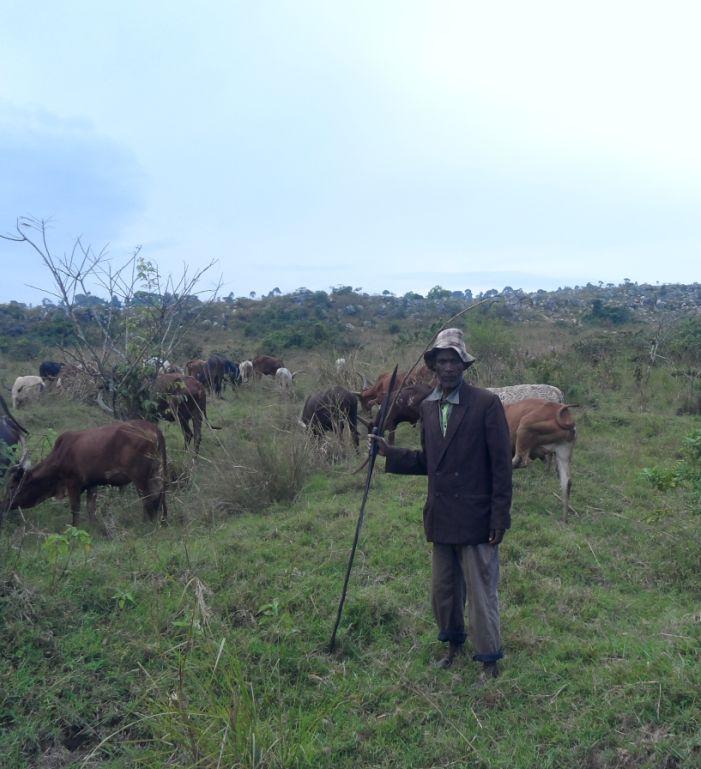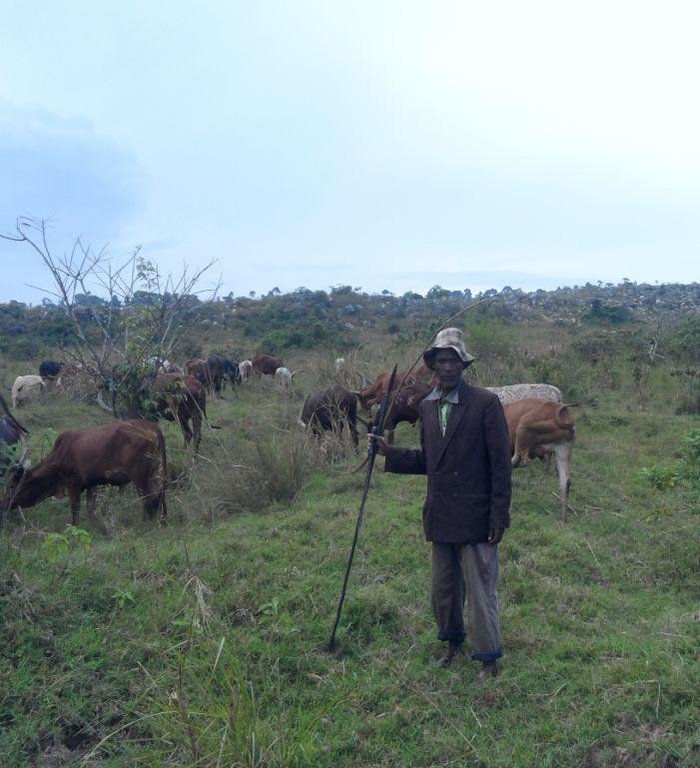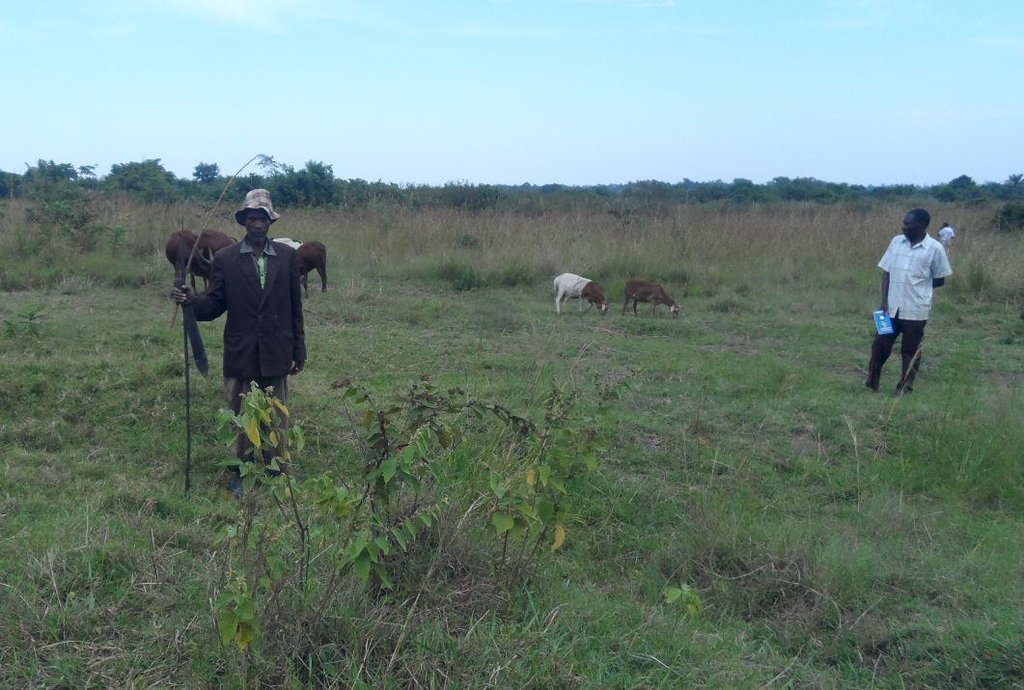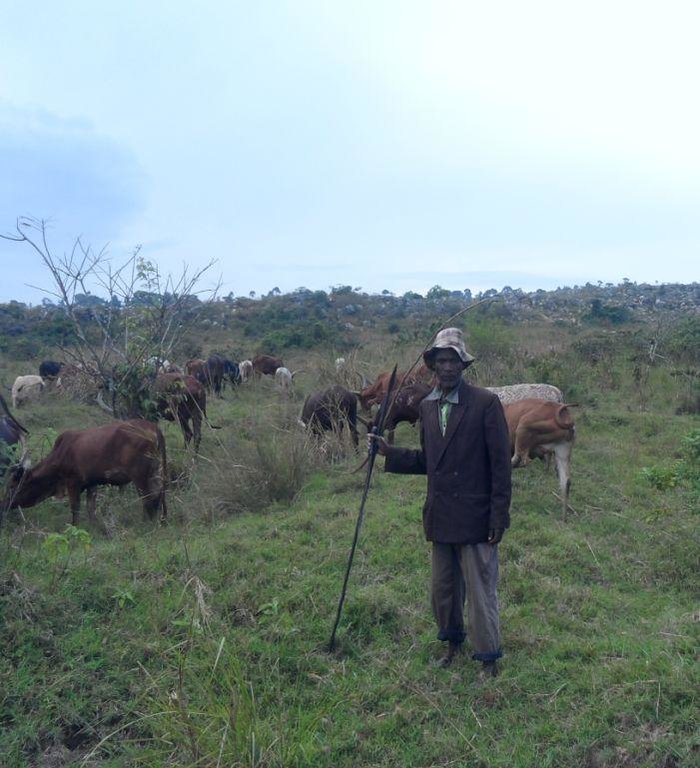Active participation of herder leader (WAKONDO) in management of grassland and riverine ecosystems [Бүгд Найрамдах Нэгдсэн Танзани Улс]
- Шинийг нээх:
- Шинэчлэх:
- Мэдээлэл цуглуулсан: ALLAN BUBELWA
- Редактор: –
- Хянагч: Fabian Ottiger
Matumizi ya wamiliki wa mifugo (WAKONDO) katika hifadhi na matumizi bora ya nyanda za malisho na bionwai za mto.
approaches_2488 - Бүгд Найрамдах Нэгдсэн Танзани Улс
Бүлгүүдийг үзэх
Бүгдийг харуулах Бүгдийг хаах1. Ерөнхий мэдээлэл
1.2 Арга барилыг баримтжуулах болон үнэлгээ хийхэд оролцсон хүн эсвэл байгууллагын холбоо барих хаяг
ГТМ мэргэжилтэн :
ГТМ мэргэжилтэн :
Egidius Pancras
Missenyi District Council
Бүгд Найрамдах Нэгдсэн Танзани Улс
Арга барилыг баримтжуулах/үнэлэх ажилд дэмжлэг үзүүлсэн байгууллага(ууд)-ын нэр (шаардлагатай бол)
Bukoba district council (Bukoba district council) - Бүгд Найрамдах Нэгдсэн Танзани УлсАрга барилыг баримтжуулах/үнэлэх ажилд дэмжлэг үзүүлсэн байгууллага(ууд)-ын нэр (шаардлагатай бол)
Missenyi District Council (Missenyi District Council) - Бүгд Найрамдах Нэгдсэн Танзани Улс1.3 WOCAT-аар баримтжуулсан өгөгдлийг ашиглахтай холбоотой нөхцөл
Мэдээллийг хэзээ (газар дээр нь) цуглуулсан бэ?
03/06/2014
Эмхэтгэгч болон гол мэдээлэгч хүн(хүмүүс) WOCAT аргачлалаар баримтжуулсан мэдээллийг ашиглахтай холбоотой нөхцлийг хүлээн зөвшөөрсөн.
Тийм
1.4 ГТМ-ийн технологийн асуулгын(д) суурь мэдээлэл(д)
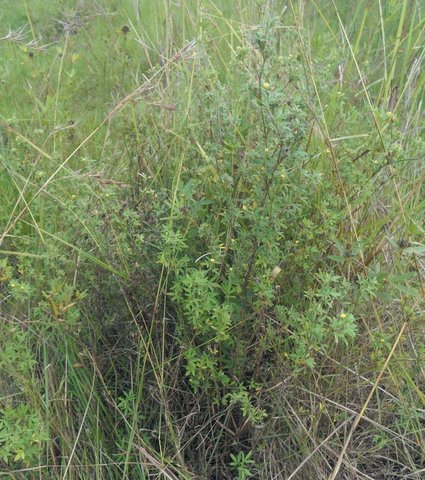
Area enclosures for protection of riverine ecosystem and … [Бүгд Найрамдах Нэгдсэн Танзани Улс]
Area enclosures for protection of riverine ecosystem and purposeful regeneration of mulching and pasture materials for cut and carry
- Мэдээлэл цуглуулсан: ALLAN BUBELWA
2. ГТМ Арга барилын тодорхойлолт
2.1 Арга барилын товч тодорхойлолт
Prevention and mitigation of the grazing land and riverine ecosystems through mandatory grassroots meetings, law enforcement and active participation and empowerment of herder leaders’ (masters of the most resource destructive group)
2.2 Арга барилын дэлгэрэнгүй тодорхойлолт
Арга барилын дэлгэрэнгүй тодорхойлолт :
Aims / objectives: Aim/objectives: Empowering the village community, to take charge prevention and rehabilitation of the degraded and endangered grazing land and riverine ecosystem. Enhance SLM sustainability through agenda mainstreaming operationalization and formalization into existing information sharing and decision making forums. SLM be implemented through complementary and concerted efforts of the central government, local governments, grass roots institutions and the community at large. Community exposure to legal and policy framework guiding SLM and actively engaged in making informed decision.
Methods: Methods: The most resource destructive group is actively engaged and empowered to take the leading role in prevention and mitigation of the endangered and degrading riverine and grazing land ecosystems. SLM matters are formalized /operationalized and becomes permanent agenda in mandatory grassroots information sharing and decision making forums (sub village meetings, village assembly, ward development committee). The use of multi-sectorial concerted efforts that involves direct support by the central government in matters relating to SLM peace and tranquility (e.g. communities provided with mobile phone numbers for timely reporting of any destructive fire incidence and other environmental and peace threatening malpractices). Knowledge management and training (farmer capacity building) scaled up through adult learning methods (e.g. SLM demos). Active involvement of the most resource destructive group (herdsmen and their masters) in planning, implementation, monitoring and evaluation, decision making and bylaw formation and reinforcement. Herders who usually suffer rights to information (due to their tight daily activity clock) are informed, lead and guided by their masters.
Stages of implementation: Implementation starts with land degradation analysis and identification of the red spots (land degradation problems) to be addressed. Development of community SLM site specific action plan indicating the degradation type, proposed prevention and mitigation intervention methods, conservation methodology/approach to use, inputs needed, people /stakeholder involvement and time frame, stakeholder awareness raising plan, training, education and capacity building. Roles distribution, joint implementation, monitoring and evaluation of community action plan.
Role of stakeholders: Community: take charge of SLM activities (e.g. land demarcation, planting of tree, reseeding of pasture, e.t.c.), potential informer of malpractices and play a role of grass roots community guard, detectors of SLM crimes are also responsible for up keeping of public order.
Sub and village governments: formation of village environmental committees, taking leading role in inclusion of SLM agendas in mandatory sub village and village meetings, community mobilization and law enforcement.
WAKONDO: forms the core stakeholders in this approach (as experience shows that herders are the major source of uncontrolled fire burning and intruders of riverine ecosystems), participate in decision making and bylaw formation, guide and frequently remind and lead herders how and where to graze, interpreted bylaws to herders so that they make wise and informed decision and liaise herders with sub village and village government.
Environmental committee: law enforcers, environmental patrollers, direct involvement in SLM activities, awareness creation through various means e.g. use of posters.
District council: Awareness creetion, training, education and capacity building and interpreting to the community laws and policy guiding SLM.
Central government: SLM peace and tranquility and law enforcement.
Other important information: The basic principle underlying this approach is facing SLM through multi-sectorial collaboration and active participation of the most resource destructive group of the community. The average annual costs needed in running the approach is > 2000 USD.
2.3 Арга барилын зурагууд
2.5 Арга барил нэвтрүүлсэн улс орон / бүс нутаг / байршил
Улс :
Бүгд Найрамдах Нэгдсэн Танзани Улс
Улс/аймаг/сум:
Tanzania/Kagera
Байршлын дэлгэрэнгүй тодорхойлолт:
Missenyi/Kitobo/Kyazi
2.6 Арга барилыг эхлэх, дуусах огноо
Эхлэх жилийг тэмдэглэ:
2012
Хугацаа дуусах жил (Хэрэв арга барил удаанаар ашиглаагүй бол):
2014
2.7 Арга барилын төрөл
- Local initiatives mixed in a comprementary maner with project project initiatives.
2.8 Арга барилын үндсэн зорилго, зорилтууд
The Approach focused mainly on SLM with other activities
Empowering and involvement of the community by building confidence, ownership and capacity to take charge prevention and mitigation of the degraded and endangered grazing land and riverine ecosystem. Establishment of active and reliable environmental committee. Make SLM to be permanent agenda and formalized into existing information sharing and decision making forums.
SLM be implemented through complementary and concerted efforts of the central government, local governments, grass roots institutions and the community at large.
The SLM Approach addressed the following problems: Overgrazing and uncontrolled fire burning by herders, who undertake animal caring for WAKONDO (livestock owners), their activity clock is usually occupied and is under the control of their masters, they are voice less, no access to information about SLM, weak and have no power in decision making.
WAKONDO not adequately and effectively engaged in planning and implementing SML activities.
Dormant and inactive environmental committee coupled with lack of SLM technical knowledge.
No clearly defined grassroots forums for developing and dealing permanently with SLM agendas.
Weak, conflicting and disjointed efforts invested to environmental conservation.
2.9 Арга барилын хүрээнд хэрэгжсэн Технологи/Технологиудад дэмжсэн эсвэл саад учруулсан нөхцлүүд
нийгэм / соёл / шашны хэм хэмжээ, үнэт зүйлс
- Хазаарлалт
Poor grazing techniques characterized by overgrazing and uncontrolled fire burning.
Treatment through the SLM Approach: Active training and engagement of WAKONDO (cattle owners) in planning, implementation, monitoring, evaluation and SLM decision making.
санхүүгийн нөөц, үйлчилгээний хүртээмж / боломж
- Хазаарлалт
Low quick financial realization by members of the village community who invest their valuable time in SLM (e.g. members of environmental committee)
Treatment through the SLM Approach: Introduce environmental based quick win project (QWP) and income generating activities (IGA).
Бүтэц зохион байгуулалт
- Хазаарлалт
Weak and ineffective commitment of the local governments at the grassroots level (sub village, village and ward).
Treatment through the SLM Approach: SLM be formalized as one of the permanent agenda in grassroots planning and decision making forums (mandatory village and sub village meetings).
Хууль, эрхзүйн хүрээ (газар эзэмшил, газар, ус ашиглах эрх)
- Идэвхижүүлэх
The existing land ownership, land use rights / water rights moderately helped the approach implementation: The current bylaws contribute significantly in adherence to environmental conservation and approach objectives.
- Хазаарлалт
Unlimited and uncoordinated use of grazing and riverine resources. Inadequate law enforcement. Low engagement of the central government (law enforcers and observers of peace and tranquility).
Treatment through the SLM Approach: Demarcation and encrosure of engendered grazing land and riverine ecosystems coupled with use of sign/warning posters. Active engagement of the central government (law enforcers and observers of peace and tranquility) e.g. community awareness and access to DCs phone for reporting crimes and any environmental threatening malpractices.
ГТМ-ийн талаарх мэдлэг, техникийн дэмжлэг авах боломж
- Хазаарлалт
Unintended results in management of the grazing land ecosystem (e.g. emergency of invasive species)
Treatment through the SLM Approach: Research and find alternative use of the invasive species and mobilize for controlled and organized consumption.
ажлын багтаамж, хүн хүчний нөөц бололцоо
- Хазаарлалт
High work load to members of village environmental committee.
Treatment through the SLM Approach: Development of regular time table and are the priority and potential beneficiaries of IGA.
3. Оролцогч талуудын оролцоо ба үүргүүд
3.1 Арга барилд оролцогч талууд болон тэдгээрийн үүргүүд
- Орон нутгийн газар ашиглагч / орон нутгийн иргэд
Community at large, Environmental groups/commitees, WAKONDO and herders. Individual local communities (youth, elders, male and females)
Farmer groups, environmental committees (males and females). Almost gender balanced environmental committee, active participation of the youth and indiscriminate participation of disabled (as a matter of fact the chairperson of environmental committee is an handicapped)
- ГТМ-ийн мэргэжилтэн/ хөдөө аж ахуйн зөвлөх
Site facilitators (all males), District SLM multidicipline team (femals and males) . District Planning Team
- Орон нутгийн захиргаа
District, Village and Sub village governmen, village leaders and ward community representatives (Councilors).
- Засгийн газар (шийдвэр гаргагч, төлөвлөгч)
Central Government
- Олон улсын байгууллага
Transboundary Agroecosystem Project (TAMP)
3.2 Арга барилын янз бүрийн үе шатанд орон нутгийн газар ашиглагчид / бүлэглэлүүдийг татан оролцуулах
| Орон нутгийн газар ашиглагч / орон нутгийн иргэдийн оролцоо | Хэн оролцсоныг тодорхойлж, үйл ажиллагааг тайлбарлана уу | |
|---|---|---|
| санаачлага/идэвхжүүлэлт | интерактив | Village council members and field experts - sensitization and awareness creation meetings. |
| Төлөвлөгөө | интерактив | Village government, community and site facilitators - SLM planning meetings. |
| Хэрэгжилт | интерактив | Village government, community, groups and committees and site facilitators - Actual implementation of community site specific action plan. |
| Мониторинг/ үнэлгээ | интерактив | Village government, community, groups and committees and site facilitators - Actual monitoring and evaluation of community site specific action plan. |
| Research | интерактив | Village government, community, groups and committees and site facilitators - client focused research to deal with undesirable and unintended results (e.g. on how to handle invasive species). |
3.4 ГТМ-ийн технологи/технологиуд сонгох шийдвэр
Хэрэгжүүлэх Технологи/Технологиудын сонголтыг хийж шийдвэр гаргасан хүнийг тодорхойлно уу:
- ГТМ-ийн мэргэжилтнүүдийн дэмжлэгтэйгээр, голчлон газар ашиглагчид
Тайлбар :
Decision over the technology was a resultant of site characterization technically backstopped by SLM specialists and actively participated by the empowered and informed community.
Decisions on the method of implementing the SLM Technology were made by mainly by land users supported by SLM specialists. The method was the resultant of a process phases and steps dialogue, discussion and consensus attained between land user and SLM specialists.
4. Техникийн дэмжлэг, чадавхи бүрдүүлэх, мэдлэгийн менежмент
4.1 Чадавхи бэхжүүлэх/сургалт
Газар эзэмшигчид / бусад оролцогч талуудад сургалт явуулсан уу?
Тийм
Хэн сургалтанд хамрагдсан бэ:
- Газар ашиглагчид
- хээрийн ажилтан / зөвлөх
- leaders and politicians
Хэрэв шаардлагатай бол хүйс, нас, яс үндэс, гэх мэт. нэмнэ үү:
all gender (male and female), all age (youth and elders), all status (the rich WAKONDO and the poor herders) and all ethnic group
Сургалтын хэлбэр :
- Ажил дээр
- үзүүлэнгийн талбай
- Олон нийтийн уулзалт
Сургалтын хэлбэр :
- special and adhoc serminars
Хамрагдсан сэвдүүд:
Fire control, grazing management, forest management, pasture establishment and use of bylaws.
4.2 Зөвлөх үйлчилгээ
Газар ашиглагчдад зөвлөх үйлчилгээ авах боломжтой байдаг уу?
Тийм
Зөвлөх үйлчилгээ үзүүлсэн эсэхийг тогтоо:
- Газар ашиглагчийн талбай дээр
Тодорхойлолт / тайлбар:
Name of method used for advisory service: Group method ; Key elements: Site vist and stakeholders visit, Group discussion, interaction and concensus building, local knowledge and technical knowledge balanced in a comprementary manner; Land users were visited by the experts and discussions held either on the site or elsewhere.
Advisory service is inadequate to ensure the continuation of land conservation activities; There is shortage of staff and the few staff have high workload/are given multiple tasks.
4.3 Институцийг бэхжүүлэх (байгууллагын хөгжил)
Арга барилаар дамжуулан институц байгуулагдаж эсвэл бэхжсэн үү?
- Тийм, бага
Байгууллагууд бэхжиж, үүсэн бий болсон түвшин(үүд)-г тодорхойлно уу:
- Орон нутгийн
Дэмжлэгийн төрлийг ялга:
- чадавхи бэхжүүлэх / сургалт
Дэлгэрэнгүй мэдээллийг өгнө үү:
Members of environmental committee were provided with various SLM trainings.
4.4 Мониторинг ба үнэлгээ
Мониторинг болон үнэлгээ нь арга барилын хэсэг үү?
Тийм
Тайлбар:
bio-physical aspects were regular monitored by land users through observations; indicators: number of pasture growing species
technical aspects were regular monitored by project staff, land users through measurements; indicators: percentage increase in vergetation cover
socio-cultural aspects were ad hoc monitored by land users through observations; indicators: incedences of fire burning
economic / production aspects were regular monitored by land users through measurements; indicators: number of grass bundles harvested
area treated aspects were regular monitored by land users through measurements; indicators: % hacterage protected and harvested
no. of land users involved aspects were regular monitored by land users through measurements; indicators: number of adopters/participants
management of Approach aspects were regular monitored by land users through observations; indicators: Number of FFS, Demos and IGA, patrols meetings
There were several changes in the Approach as a result of monitoring and evaluation: arrangement for the community to find alternative uses of unintended products in pasture establishment (alternative use of invasive species) .
There were several changes in the Technology as a result of monitoring and evaluation: Monitoring and evaluation revealed the need to integrate SLM quick win project/IGA as stimulus factor to members of environmental committee who spend their valuable time in performing SLM activities.
5. Санхүүгийн болон гадаад материаллаг дэмжлэг
5.1 ГТМ-ийн Арга барилын бүрэлдэхүүн хэсгийн жилийн төсөв
Хэрэв жилийн төсөв тодорхойгүй бол хягаарыг тодруулна уу:
- < 2,000
Тайлбар (жнь: санхүүжилтийн гол эх үүсвэр / гол хандивлагчид):
Approach costs were met by the following donors: international (Transboundary Agroecosystem project): 25.0%; government (Central Government ): 5.0%; local government (district, county, municipality, village etc) (Village government and District council ): 18.0%; local community / land user(s) (Community, groups, village invironmental commitees ): 52.0%
5.2 Газар ашиглагчдад санхүүгийн / материаллаг дэмжлэг үзүүлсэн
Технологи / технологийг хэрэгжүүлэхэд газар ашиглагчид санхүүгийн / материаллаг дэмжлэг авсан уу?
Тийм
5.3 Тодорхой зардлыг даахад чиглэсэн дэмжлэгт (хөдөлмөрийн хүчийг оролцуулаад)
- Хөдөө аж ахуй
| Ямар хөрөнгө оруулалт татаасаар олгогдсоныг заана уу | Ямар талбайн хэмжээнд | Тэтгэмж, урамшууллыг тодорхойлно уу |
|---|---|---|
| Үр, үрсэлгээ | Бүрэн санхүүждэг | Pasture seed |
| Бордоо | хэсэгчлэн санхүүждэг | DAP |
Хэрэв газар ашиглагчийн хөдөлмөрийн хүч чухал байсан бол энэ нь аль хэлбэр байсан:
- бусад материаллаг дэмжлэгээр шагнагдсан
Тайлбар:
the were rewarded indirectly through IGA and input provision
pasture seeds were supported fully but fertilizer was inadequate due to lean budget.
5.4 Кредит
Арга барилын хүрээнд ГТМ-ийн үйл ажиллагаанд зориулж зээлд хамрагдсан уу?
Үгүй
6. Нөлөөллийн дүн шинжилгээ ба дүгнэлт
6.1 Арга барилын нөлөөллүүд
Арга барил нь ГТМ-ийн технологийг хэрэгжүүлж, хадгалахад газар ашиглагчдад тусласан уу?
- Үгүй
- Тийм, бага зэрэг
- Тийм, зарим
- Тийм, их
Improvement of vegetation cover through controlled fire burning, livelihood diversification through sell of mulching and pasture materials, protection of the grazing land and riverine ecosystem ensured through area enclosure, demarcation and controlled harvesting of mulching and pasture materials.
Арга барил нь эмзэг бүлгийнхнийг нийгэм, эдийн засгийн хувьд чадавхижуулсан уу?
- Үгүй
- Тийм, бага зэрэг
- Тийм, зарим
- Тийм, их
Youth, women and the disabled interms of livelihood and income
Did other land users / projects adopt the Approach?
- Үгүй
- Тийм, бага зэрэг
- Тийм, зарим
- Тийм, их
Did the Approach lead to improved livelihoods / human well-being?
- Үгүй
- Тийм, бага зэрэг
- Тийм, зарим
- Тийм, их
additional income accrued through mulching and pasture materials to casual labour, transporters and farmers.
Did the Approach help to alleviate poverty?
- Үгүй
- Тийм, бага зэрэг
- Тийм, зарим
- Тийм, их
Alternative income sources and improved money circulation.
6.2 ГТМ-ийг хэрэгжүүлэх газар ашиглагчидын гол санаачилга
- үйлдвэрлэл нэмэгдсэн
expectation of getting high palatable pastures and mulching material for use and sale
- Ашиг нэмэгдсэн (боломж), зардал-үр ашгийн харьцаа сайжирсан
Profit realized from improved animal and crop production arizing from use of pasture and mulch
- дүрэм журам (торгууль) / сахиулах
People worry purnishment in terms of pernaties and standing before the court of law.
- Сүлжээ/ бүлэг төсөл/ хөдөлгөөнд гишүүнээр элсүүлэх
Benefit from SLM projects in terms of IGA and easy access to extension services.
- Байгаль орчны ухамсар
Change of mindset through awareness creation and sensitization meetings/seminars.
- well-being and livelihoods improvement
dirvesification of income sources (income from the sell of mulching and pasture materials)
6.3 Арга барилын үйл ажиллагааны тогтвортой байдал
Газар ашиглагчид арга барилаар дамжуулан хэрэгжүүлсэн арга хэмжээг тогтвортой хадгалж чадах уу (гадны дэмжлэггүйгээр)?
- Тийм
Хэрэв тийм бол яаж гэдгийг тайлбарлана уу:
Because the approach is internationalized and formalized into the existing systems (e.g. SLM becomes permanent agenda in mandatory sub village and village meetings).
The use of goat loan IGA project where farmers are given goats on loan bases and pay goats which are then passed and spread to more of their fellow farmer can continue without support.
Involvement of central government e.g. access of district commissioners and divisional officers phone is a reliable SLM crime control mechanisms which does not require any of external support (a mere text message can save and protect abundant hectare of land).
6.4 Арга барилын тогтвортой/давуу тал/боломжууд
| Газар ашиглагчдын тодорхойлсон давуу тал/боломжууд |
|---|
| Improvement of the natural vegetation (How to sustain/ enhance this strength: To continue community education ) |
| Availability of mulching materials (How to sustain/ enhance this strength: Controlled harvesting and fire prevention ) |
| Availability of fuel wood (How to sustain/ enhance this strength: Permanent and routine guard ) |
| Эмхэтгэгч, бусад мэдээлэл өгсөн хүмүүсийн өнцгөөс тодорхойлсон давуу тал/боломжууд |
|---|
| Incorporation internalization of SLM as permanent agenda in reliable mandatory grassroots forums (sub village and village meetings) (How to sustain/ enhance this strength: Continue internalization and SLM promotion through use of existing forums.) |
| Involvement of the central government (a mere text message can save and rescue abundance of hectare). (How to sustain/ enhance this strength: Continue use of the central government.) |
| Empowerment and active participation of the the most resource destructive and environmental threatening group (livestock keepers). (How to sustain/ enhance this strength: Continue use of WAKONDO (livestock owners) in planning, implementation and deciding SLM activities. ) |
| Use of self spreading IGA to motivate environmental committee members who spend their valuable time in SLM activities (e.g. goat loan projects). (How to sustain/ enhance this strength: Continue promotion, expansion and sustaining of self spreading IGAs.) |
| Dialogue and communication takes into consideration the daily activity clock of the stakeholder (through this principle WAKONDO can deliver SLM messages to herdsmen rather than SLM specialist) (How to sustain/ enhance this strength: Daily activity clock continue to be a criteria for planning SLM dialogue and communication.) |
6.5 Арга барилын дутагдалтай/сул тал/аюул болон тэдгээрийн хэрхэн даван туулах арга замууд
| Газар ашиглагч нарын тодорхойлсон сул тал/ дутагдал/ эрсдэл | Тэдгээрийг хэрхэн даван туулах вэ? |
|---|---|
| shortage of working gears (umbrella, gumboots, raincoats and stationary) | Ensure availability of working gears (e.g. SLM penalties be used to cover the costs of working gears). |
| Inadequate fund to support IGA | Commit adequate fund to support and expand IGA. |
| Violation of rules and procedures by some untrustworthy individuals | Strengthen law enforcement (use of penalties, court and ward tribunals) |
| No reliable transport for village environmental committees. | Ensure reliable transport for the village environmental committee. |
| Эмхэтгэгч, бусад мэдээлэл өгсөн хүмүүсийн өнцгөөс тодорхойлсон сул тал/ дутагдал/ эрсдэл | Тэдгээрийг хэрхэн даван туулах вэ? |
|---|---|
| Existence of untrained-able and lazy herdsmen and less committed WAKONDO. | Strengthen law enforcement (e.g. use of penalties) |
| No reliable forum to collaborate with supplier of inputs and research as a results failure to figure out the reasons for unintended results (for this case unpalatable alien/native species overshadowed the palatable pasture and the reasons were not known) | Strengthen collaborations with Research and supplier of inputs (pasture seeds e.t.c.). |
7. Суурь мэдээлэл болон холбоосууд
7.1 Мэдээллийн эх үүсвэр/аргууд
- Хээрийн уулзалт, судалгаа
- Газар ашиглагчтай хийсэн ярилцлага
7.2 Холбогдох бүтээлийн ишлэл
Гарчиг, зохиогч, он, ISBN:
A report on Kyazi Microcatchment Characteriaztion
Холбоос ба модулууд
Бүгдийг харуулах Бүгдийг хаахХолбоосууд

Area enclosures for protection of riverine ecosystem and … [Бүгд Найрамдах Нэгдсэн Танзани Улс]
Area enclosures for protection of riverine ecosystem and purposeful regeneration of mulching and pasture materials for cut and carry
- Мэдээлэл цуглуулсан: ALLAN BUBELWA
Модулууд
Модуль байхгүй байна


